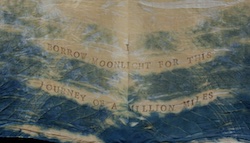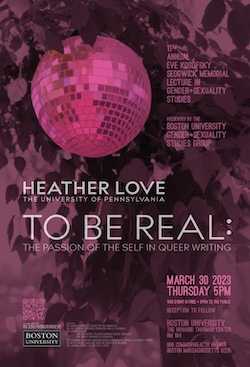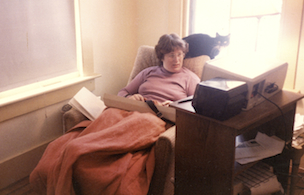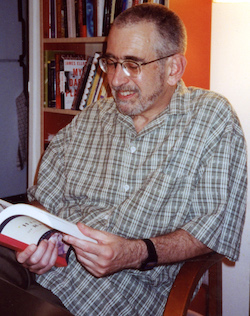BLOG
ANNIE SANSONETTI ON WORKING WITH THE SEDGWICK ARCHIVE AT DUKE
Image caption: An undated photograph of Eve Sedgwick in Greenwich Village. (Photo: Hal Sedgwick)
Annie Sansonetti is one of two inaugural recipients of the Eve Kosofsky Sedgwick Travel Grant to support the development of new work engaging with the Sedgwick archive at Duke. Her project is titled “Feminine Boyhood and Trans Girlhood Onstage.”
There is a photograph of my best friend and I as children that I especially love. The year is 2002. In the photo, I am in her “girl” clothes and she is in my “boy” clothes. We pose, my hand on my hip, her arm by her side. We smile with our other arms around each other. I remember our debut in her big, sun-filled kitchen: coffee and pastries on the table and the surprise on our parents’ faces. Laughter ensued, someone took a photo, and we played in our shared clothing all day. I assume that I eventually swapped her clothes for mine, although this moment does not stand out in my mind. The memory of my friend’s roomy walk-in closet and our subsequent exit of it—down the spiral staircase hand in hand, with our footsteps set to a symphony of our giggles—does.
I call this moment, and the gendered and (trans)sexual activity that transpired there, “Eve’s closet.” Play in Eve’s closet is my descriptor for queer and trans pleasure in the curvature of sexual and gendered spaces, what Sedgwick described in a response to an essay by Jacob Hale as an “identification with what is, at any given moment, understood to be the growing edge of a self.” It recalls moments of childhood play—“of daring surmise and cognitive rupture”—between queer and trans kids (here trans feminine and trans masculine), where clothing, make-believe, and toys are the “very stuff” of queer sexuality and/or where friendship is a medium for gender transition or sex change. Eve’s closet is a funhouse for kids: comprised of many entrances and exits, where they are encouraged to come in and come out when they are ready. It is like a theatre’s backstage, or a dressing room, where costume choices are endless. In Eve’s closet, and in play among children, even bridal lingerie has queer and trans potential.
I visited the Eve Kosofksy Sedgwick papers at Duke University’s Rubenstein Library with an interest in Sedgwick’s writing on trans feminine childhood—what was then-called “feminine boyhood,” “boyhood effeminacy,” or “boyhood femininity” in common parlance of queer theory in the 1990s. I am interested in how stories of trans feminine childhood—of feminine boyhood and trans girlhood—have been written and performed in theatre and the performing arts, especially when friends (or other queer- and trans-loving collaborators) are the chosen or desired audience members or co-stars. I read an early 1989 draft of her now-famous essay “How to Bring Your Kids Up Gay,” later re-published in Tendencies in 1993 with the subtitle “The War on Effeminate Boys,” as well as her lesser-known 1989 essay “Willa Cather and Others” on Cather’s 1905 short story titled “Paul’s Case: A Study in Temperament.” But I soon became fascinated by Sedgwick’s collaborations with her best friend and once-roommate Michael Moon, especially their co-authored 1990 essay, more of a “performance piece,” on the topic of “divinity,” what they called “a little-understood emotion.”
In “Divinity,” Moon and Sedgwick reflect on the “roominess” of the fat woman’s body—and her closet—for the feminine boy. While I am interested in the content of the essay (especially a film still of Divine and the “Infant of Prague” from John Waters’ 1970 film Multiple Maniacs, and I certainly have my own stories of play in fat women’s closets as a girly-boy), for the purposes of this report, I want to dwell on Moon and Sedgwick’s collaboration for what it teaches us about the pleasure and play of the trans masculine and trans feminine relation. In Sedgwick’s papers, there are multiple drafts of “Divinity”—some with misplaced paragraphs, others with Moon’s and Sedgwick’s marginalia, and a few with Moon’s initials swapped for Sedgwick’s and vice versa, as if they were sharing and exchanging each other’s voices, or playing dress up with each other’s bodies, if you will.
Moon and Sedgwick both spent time in the closet. Moon as a “proto-gay,” feminine boy and Sedgwick as a fat woman who accompanied them there (and who was, especially in her white glasses, a fat woman who was a gay man). But they also stepped outside them quite proudly and defiantly, both together and apart, like me and my friend. For Moon and Sedgwick, their play-space was writing; for my friend and I, it was clothing. Inspired by Moon and Sedgwick’s essay and my photograph, we might make the claim that queer and trans children’s play with each other (both “actual” children and the inner child of the queer or trans adult who is “co-present,” not gone, after Mary Zaborskis) can constitute felt and pleasurable enactments of queer sexuality and/or gender transition beyond the confine of an “adult”—legal, medical, and political—form of legibility and between friends.
Play in each other’s shared clothing is co-authorship. It a chance for queer and trans kids to stage the bodies and lives they want for themselves and their friends, at least for the time being, and until they have the autonomy to demand more from the world at the level of sexual and gender-determination in an adult-centric world. In extant queer and trans scholarship and popular culture, tomboys and sissies are often staged far apart from each other. But what about their conviviality and solidarity—the “I have what you need/want, you have what I need/want” kind of mutual aid? Think: my photograph. It occurs to me that in our play, a repertoire that was certainly “t4t,” we relished the share of clothing, bodies (body parts?), and toys that sustained our queer and trans childhood—little-by-little, day-by-day, and moment-by-moment, like the best scenes of queer and trans childhood’s “divinity.”
In this sense, play among queer and trans children is best encapsulated in Sedgwick’s last words on the “divine” collaboration between Divine and Waters (and, I add, herself and Moon, and me and my friend). This play, is, as Sedgwick writes, “as scarce as it is precious.” It offers us “opulent images and daring performances that suggest the experiment of desires that might withstand the possibility of their fulfillment.” In the absence of a certain fulfillment, there is no “finale” to such play’s enactment of desire. Instead, there are only a bunch of opulent and daring debuts with the friends who withstand the often frustrated, unrealizable experiments in queer and trans desire with you.This is“Eve’s closet,” where children can change their genders/sexualities, stage a scene, and strike a pose with a friend, always as if for the first time. There may even be someone queer- and trans-loving around to photograph it.
–Annie Sansonetti
RELATED - ARCHIVE
2023-2024 RECIPIENTS OF THE EVE KOSOFSKY SEDGWICK TRAVEL GRANT ANNOUNCED
The David M. Rubenstein Rare Book & Manuscript Library at Duke University has announced the recipients of this year’s Eve Kosofsky Sedgwick Travel Grants. Annual travel grants to support research using the Eve Kosofsky Sedgwick Papers at the Sallie Bingham Center are funded by the Eve Kosofsky Sedgwick Foundation and administered through Duke University’s Rubinstein Rare Book & Manuscript Library. We congratulate this year’s grant recipients and look forward to their work.
The 2023-2024 grant recipients and project titles are:
Matilde Manara, Postdoctoral Fellow, Collège de France, “Proustmania! Reading, writing, sewing Proust today.”
Christina Olivares, Ph.D. candidate, Department of English Education, Teachers College at Columbia University, “Reparative Gestures/Queering Education: Eve Kosofsky Sedwick’s pedagogical practices and James Sears’ research in adolescent education.”
Evan Pavka, Faculty, Department of Art & Art History, Wayne State University, “Reconstructing ‘Queer Space.’”
RELATED - GRANTS
2023 HONORING EVE LECTURE AT BOSTON UNIVERSITY
The 11th annual Boston University Eve Kosofsky Sedgwick Lecture in Gender & Sexuality Studies will be delivered by Dr. Heather Love at 5pm on March 30, 2023. Dr. Love’s talk is titled “To Be Real: The Passion of the Self in Queer Writing.” The talk will be given at Boston University and recorded for future viewing.
Heather Love is Professor of English at the University of Pennsylvania. She received her A.B. from Harvard and her Ph.D. from the University of Virginia. She is the author of Feeling Backward: Loss and the Politics of Queer History (Harvard) and the editor of a special issue of GLQ on Gayle Rubin (“Rethinking Sex”) and the co-editor of a special issue of Representations(“Description Across Disciplines”). Underdogs: Social Deviance and Queer Theory (University of Chicago Press) came out in Fall 2021.
RELATED - EVENTS
DEADLINE APPROACHES FOR THE 2023-2024 EVE KOSOFSKY SEDGWICK TRAVEL GRANT
The application deadline for the 2023-2024 Eve Kosofsky Sedgwick Travel Grant, funded by the Eve Kosofsky Sedgwick Foundation and supported by the Sallie Bingham Center for Women’s History and Culture, is Friday, February 24, 2023 at 6:00 pm EST.
This opportunity offers up to $1500 to support research using the Eve Kosofsky Sedgwick Papers. In addition to supporting academic research aimed at producing publications and dissertations, these grants will support a wide range of other creative projects such as educational initiatives, exhibitions, films, multimedia products, and other artistic works. Sedgwick Travel Grant recipients will be asked to submit a brief report of their grant-supported activities at the conclusion of the grant cycle.
To apply for the Eve Kosofsky Sedgwick Travel Grant, visit the Rubinstein Library’s page.
RELATED - GRANTS
JONATHAN GOLDBERG, 11 JUNE 1943–9 DECEMBER 2022
Jonathan Goldberg, a dear friend of Eve Kosofsky Sedgwick, passed away on December 9th following a long illness. As detailed in his obituary, published on Sunday, December 18, in the New York Times, Goldberg was a highly influential and prolific scholar working in “the fields of early modern British literature, poststructuralist literary studies, and LGBTQ studies and queer theory.” Among his many other accomplishments, Goldberg made invaluable contributions to the dissemination and evaluation of Sedgwick’s work.
When Sedgwick came to Duke University in 1988, Goldberg was on the faculty of Johns Hopkins University, but he was coming frequently to Duke to visit his partner, Michael Moon, who had joined the Duke faculty the year before. Sedgwick soon became close friends with both Moon and Goldberg. They learned from each other’s work and together participated in creating and editing Series Q at the Duke University Press, which describes the series as having brought “a theoretical and interdisciplinary lens to gay and lesbian studies, approaching questions of sexuality from a queer angle.”
Their friendship continued after Sedgwick moved to the Graduate Center of the City University of New York, while Moon and Goldberg moved to Emory University. When Sedgwick’s own illness became incurable, she asked Goldberg to be her literary executor. Following her death in 2009, Goldberg undertook the difficult task of editing her more recent unpublished manuscripts, some of which existed in multiple versions, into a coherent volume of essays (The Weather in Proust, Duke University Press, 2011). He also contributed an essay of his own to a recent collection of essays about Sedgwick’s work (Reading Sedgwick, edited by Lauren Berlant, Duke University Press, 2019). One of his last projects was a monograph assessing the critical response, following her death, to Sedgwick’s work (Come As You Are, After Eve Kosofsky Sedgwick, punctum books, 2021); this book also contains a previously unpublished talk of Sedgwick’s, “Come As You Are,” which Goldberg describes as representing “a significant bridge between her earlier and later work, sharing with her book Tendencies the ambition to discover the ‘something’ that makes queer inextinguishable.”




